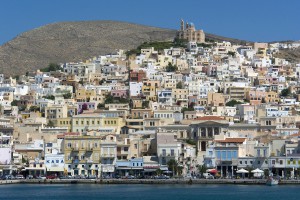We had a nice winter – but now it is about time for winter to leave us. In my heart, at least, the yearning for sun woke – which is why I will be in Cuba between the end of February and Mid-March. This is where I want to ride my bike through the summer – and then I want to return home to spring. Also, I want to spend very little time in the internet during those two weeks. Instead, I want to open my eyes wide for reality and see many beautiful, but also serious, things.

But then, you do not have to go all that far, do you? After all, the Cyclades are now in Munich. A short time ago, a wonderful exhibition opened at the Archaeological State Museum. It brings you into the ancient European South.
You are brought back to Greece, which is a country currently spiralling down in free fall (see SZ of February, 21st, 2012). And as I see it, more than just the historical mistakes the Greeks made are to blame. The very arrogant and simplifying policy of the EU during the last years is just as much responsible. After all, in the wake of the introduction of the Euro, Greece had no chance of survival – which, incidentally, is true for some other countries, as well.
Consequently, visiting the exhibition might also be something you want to do out of solidarity. It gives you the chance of watching what happened during the last 5,000 years in a breath-taking way.
Venus by Milo, proof of how prosperous the islands were in Hellenic times.
“CYCLADES – EARLY ART IN THE AEGIS” 13.02.2015 – 07.07.2015
Here are a few sentences you will find in the preview (Vorschau).
Arranged like a chain of pearls, the Cyclades lie in the blue ocean of the Aegis. A mild climate with constant winds and fertile soil on volcanic stone were the roots on which a highly developed culture grew during the transitory time between stone age and bronze age, around 3,000 b. C.
Natural resources were the basis for the technological development in processing stone, extracting metal and working clay. Using ocean-going long boats, the islanders traded between the coasts of Asia Minor and Crete, making their islands the hub for cultural contacts in the Eastern Mediterranean.
…
The figurines and the objects found along with them made of stone, metal and clay are presented in accordance with the cultural insights found by scientific research. You are presented the concept of a fascinating world of islands which starts a dialogue with us, overcoming a time span of 5,000 years.
So this is where you want to go. And see yourself what a country which in today’s Europe is reduced to getting scolded by the teachers used to deliver. A country which is often pilloried, even though it did not do anything significantly different from what other Southern European countries did. In a European Union where far from all that glitters is gold – which is also true for the oh-so-superior Federal Republic of Germany that dominates all Europe.
RMD
(Translated by EG)
P.S.
I took both pictures from Wikipedia.
The first one is a picture of Syros: ”Syros ermoupolis 140707“ by Hans Peter Schaefer, http://www.reserv-a-rt.de –own photography. Licenced under CC BY-SA 3.0 through Wikimedia Commons.
The second one shows the “Venus de Milo Louvre“, a photo by mzopw. licenced under common property through Wikimedia Commons.

